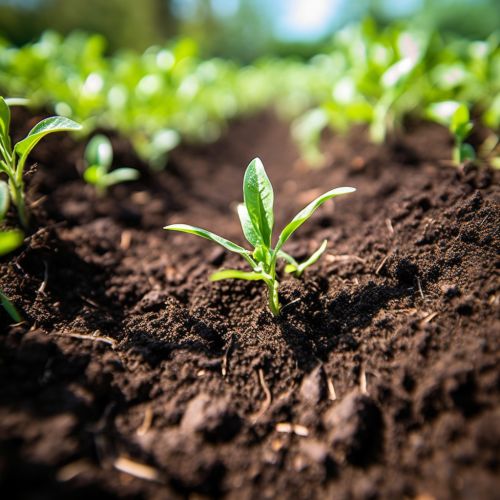Humus
Introduction
Humus is the organic component of soil, formed by the decomposition of leaves and other plant material by soil microorganisms. It is a complex substance, rich in nutrients and beneficial to plant growth. Humus is a key component of fertile soils and plays an important role in the carbon cycle, the nutrient cycle, and the water cycle.
Composition
Humus consists of organic compounds, including sugars, amino acids, and phenolic compounds. These compounds are the end products of the decomposition of plant and animal material, primarily by soil microorganisms such as bacteria and fungi. The process of humus formation, known as humification, involves the breakdown of complex organic molecules into simpler ones, followed by the synthesis of these simpler molecules into humic substances.
Humic substances are the major components of humus and are categorized into three main types: humic acids, fulvic acids, and humin. Humic acids are the largest and most complex of the humic substances. They are dark brown to black in color and are soluble in water under alkaline conditions. Fulvic acids are smaller and less complex than humic acids. They are yellow to light brown in color and are soluble in water under both acidic and alkaline conditions. Humin is the fraction of humus that is not soluble in water at any pH and has a high molecular weight.


Role in Soil Fertility
Humus plays a critical role in soil fertility. It improves the physical properties of soil, increasing its water-holding capacity and improving its structure, which enhances root penetration and growth. Humus also increases the cation exchange capacity (CEC) of soil, which is its ability to hold and exchange cations (positively charged ions). This is important for the retention of nutrients in the soil, as many essential plant nutrients are cations, including potassium, calcium, and magnesium.
In addition to its physical benefits, humus also provides chemical benefits to soil. It acts as a buffer, helping to maintain a stable soil pH, which is crucial for nutrient availability. Humus also contains a variety of essential nutrients for plant growth, including nitrogen, phosphorus, and sulfur.
Role in the Carbon Cycle
Humus plays a significant role in the carbon cycle. It is a major reservoir of carbon in terrestrial ecosystems, storing carbon that has been fixed by plants through photosynthesis. The carbon stored in humus is relatively stable and can remain in the soil for hundreds to thousands of years, making it an important component of the global carbon cycle.
The process of humification, which leads to the formation of humus, is a key part of the soil carbon cycle. During humification, organic carbon is converted into humus, a process that is mediated by soil microorganisms. This process is influenced by a variety of factors, including temperature, moisture, and the quality of the organic material being decomposed.
Humus and Climate Change
Due to its role in the carbon cycle, humus has implications for climate change. The storage of carbon in humus contributes to the sequestration of carbon, reducing the amount of carbon dioxide in the atmosphere and thus mitigating climate change. However, changes in land use, such as deforestation and conversion of natural ecosystems to agricultural land, can lead to the loss of humus and the release of stored carbon back into the atmosphere, contributing to global warming.
Conclusion
Humus is a vital component of soil, contributing to soil fertility and playing a key role in the carbon cycle. The importance of humus in terrestrial ecosystems underscores the need for sustainable land management practices that preserve and enhance soil organic matter, including humus.
